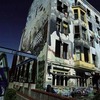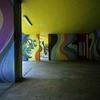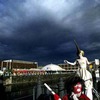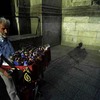Germany to reopen 6,800-year-old mystery circle
BERLIN - At the winter solstice this week, Germany is to open a replica of a mysterious wooden circle that is believed to be a temple of the sun built by a lost culture 6,800 years ago.
The circle of posts, in a flat river plain at Goseck south of Berlin, has mystified scientists since its discovery in 1991 by an archaeologist studying the landscape from the air. An excavation found post holes and what may be the remains of ritual fires.
Goseck has been dubbed the German Stonehenge, though it is twice as old as the Stonehenge megalithic circle in southern England and has no stones. The original wood rotted away long ago, but new palisades, or wooden walls, were constructed at Goseck this year.
In a public works scheme, 2,300 oaken poles were erected in a circle on the same site over a seven-month period, with gateways opening to the points of the compass where the sun rises and sets on December 21.
There are now two concentric wooden palisades, each 2.5 metres high, as well as a ditch and an earthen wall.
A winter solstice festival with flaming torches and laser lights for an audience of thousands is to take place Wednesday as the sun sets over the southwest gate of the 75-metre-diameter circle.
The Goseck Circle was apparently erected by Europe's first civilization, long before the cultures of Mesopotamia or the pyramids of Egypt, and is one of the best studied of 150 monumental sites arrayed through Germany, the Czech Republic, Austria and Slovenia.
Each comprises four concentric rings of earth and wood, indicating a common culture using a standard design.
The realization that a very early European farming people built such vast sites has arrived in little more than a decade. Textbooks that assume late Stone Age Europe was far more primitive than the Middle East must be rewritten.
Archaeologists know nothing of the appearance or language of the people and can only surmise about their religious beliefs. The culture is known only as that of stroke-ornamented ceramic ware, from fragments of pottery it left.
The jars and bowls had their decoration jabbed into the soft clay with a kind of fork to form zig-zag lines. The whole period of stroke-ornamented pottery is limited to 4900 to 4650 BC.
The Goseck Circle is claimed to have been a sort of calendar that told the people farming the fertile plain when it was time to begin counting the days till spring planting. But it may also have served as a marketplace and a place of refuge in times of war.
Francois Bertemes, who heads the prehistoric archaeology institute at nearby Halle-Wittenberg University, claims the site marks the start of world astronomy and surmises that it was a place of fertility rituals that would have included weddings.
Excavation of the 6,000-square-metre site found two "sacrificial" pits containing fragments of human bone. There was evidence of a very hot fire in both, but the ash had been removed, which Bertemes sees as a sign that humans were sacrificed.
The dig also turned up hundreds of pottery fragments and cattle bones.
Bertemes' views remain controversial.
Christoph Heiermann, spokesman for the Saxony state archaeological service, said this year that the purpose of the quadruple enclosures, which inspired his agency's new four-ring publicity logo, is still unknown.
"We prefer to just speak of central places where people gathered. We don't know what they did there. Maybe they were temples. Or markets," he said. The scientific community had not yet accepted that Goseck was an observatory.
Bus tours of Stone Age and Bronze Age sites are already coming through Goseck, which is only 25 kilometres from the German town of Nebra, where an extraordinary bronze-and-gold map of the heavens dating from 3,600 years ago was discovered in 1999.





